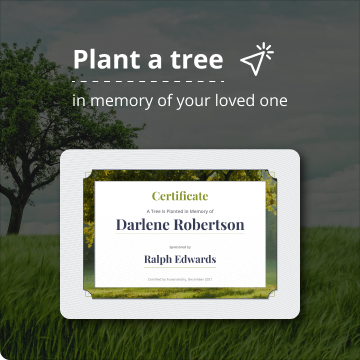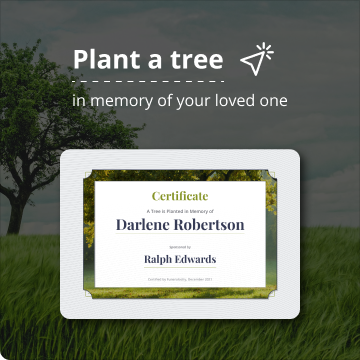
Funeral arrangements can become very confusing because of all the jargon and terms used in the industry. We understand the stress this can place on someone already dealing with grief, so in this glossary, we will be clarifying and defining all the funeral terms:
Aerial Scattering
The scattering of ashes from an airborne craft or device.
Affirmation
An Affirmation is another term for a Celebration of Life Service.
Aftercare
Aftercare is the services provided by a funeral home upon the death of the loved one, such as resources and grief support.
Alkaline Hydrolysis
A water-based dissolution process that uses heat, pressure, and alkali chemicals to gently break a human body down into chemical compounds. Once the process is complete, remaining bone fragments are allowed to cool and then processed into cremated ashes. These are then returned to the family in an urn.
Alternative Container
A container, usually made of combustible materials, used to house the remains of the deceased.
Aquamation
Aquamation is another term for Alkaline Hydrolysis.
Arrangement Conference
A discussion held between the funeral director and the family of the deceased to discuss funeral arrangements. The arrangement conference usually takes place at the funeral home. You can expect the funeral director to discuss options and prepare a contract.
Arrangement Room
The room where the arrangement conference takes place at.
Ashes
The remains of someone who has died after their body has been cremated.
Autopsy
A surgical procedure to determine the cause of death of the deceased. It is done by a professional and is required by the law in some instances and places.
Bereaved
A term used to refer to the individuals such as friends and family who have suffered the death of a loved one.
Bier
A stand that carries a coffin. It has wheels for easy movement.
Burial
Using hands or pulleys to place an expired body inside a grave.
Burial Flag
A burial flag is a flag of the country displayed at the funeral of a veteran. It is used to drape the casket during the funeral. In the United States, the burial flag is provided free of charge to honor the services of the deceased veteran.
Burial Guide
A guidebook that helps you plan a funeral.
Burial Permit
A permit that authorizes the burial of the deceased at a cemetery. The funeral director is the one who usually acquires this legal document on the family’s behalf.
Burial Planning
Burial planning is the pre-planning of a burial in advance by a person for himself or someone else.
Burial Plot
The place where the deceased is buried inside a cemetery.
Burial Vault (Casket Vault)
Required in some places by law, a burial vault is a concrete or metal container preventing the grave from sinking over time.
Cash Advance Items
A list of items bought by the funeral home on behalf of the family from a third-party vendor to facilitate the funeral.
Casket
A container, usually made of wood, used to house the body of the deceased for viewing and burial.
Casketing
The act of placing the remains of the deceased in the casket.
Celebration of Life Service
A very personalized type of funeral service with a format according to the wishes of the deceased and their family. It allows the bereaved to celebrate the life of their deceased loved one.
Cemetery
An area of land dedicated for burials in the ground or in wall crypts. Also referred to as burial grounds or graveyards.
Chapel
A room usually used for the viewing of the deceased. Most funeral homes have a chapel.
Closed Casket
A type of viewing where the casket is fully closed.
Coffin
A type of casket with wider shoulders made to house the remains of the deceased.
Columbarium
A large structure with the purpose of housing urns containing the cremated remains of the deceased. Plural: columbaria.
Committal Service
A ritual usually held at the graveside for friends and family to say prayers, last words, and farewell to the deceased.
Coroner
An official of the government with authority to investigate the identity and cause of death of a deceased person.
Cosmetizing
The process of using cosmetics by the funeral home staff to bring a life-like look to the deceased.
Condolence Flowers
Flowers given to the bereaved to express your condolences.
Cremains
Cremated remains.
Cremation
The process of applying intense heat to the remains of the deceased to turn them into ashes and bone fragments. This is done in a specialized enclosed cremation chamber.
Cremation Permit
A permit authorizing the cremation of the remains of the deceased.
Cremated Remains
The ashes and bone fragments left after the cremation of the body of the deceased.
Cremation Garden (Scattering Garden)
A special garden to facilitate the scattering of cremated remains.
Crematory
A crematory also referred to as a crematorium, is a place where cremation is done.
Crypt
A chamber, usually underground, for housing the remains of the deceased. Crypts today are designed to house casketed remains.
Death Certificate
A legal document with the details of the deceased such as personal information, date of death, and cause of death on it. The death certificate needs to be signed by a medical professional.
Death Doula
A Death Doula is another term for End-of-Life Doula.
Death Notice
A notice in the newspaper announcing the passing of the deceased.
Deceased
Deceased refers to the person who has died.
Direct Cremation
Cremation without a ceremony.
Direct Disposition
The burial of the deceased without a viewing or other such ceremonies. Also referred to as direct burial.
Display Room
A palace inside the funeral home where funeral-related items such as coffins are displayed to make the selection easier.
Disposition
The act of laying the deceased’s remains to rest, whether it is by burial or cremation.
Double-Depth Burial Plot
A type of burial plot where two people can be buried together. One of the coffins is placed atop the other one, making it a more economical option compared to purchasing two burial plots.
Embalmer
The person who performs the embalming.
Embalming
The process of preserving the body of the deceased using embalming fluids. Embalming is done by a professional embalmer.
End-of-Life Doula
An individual who works with the dying and their families to support them emotionally, spiritually and physically, but not medically.
Entombment
The act of placing the remains of the deceased in a tomb.
Eulogy
A speech, usually performed by a friend or family member, praising the deceased at the funeral.
Exhumation
The act of digging up the body of the deceased after burial. Exhumation may be done to move the grave to another place.
Family Car
A vehicle provided by the funeral home for the family of the deceased to travel from the funeral home to the cemetery. The family car provided by the funeral home is traditionally a limousine.
Family Mausoleum
A type of private mausoleum for the entombment of multiple family members. Multiple generations of a family may be entombed in the same mausoleum.
Family Plot
An area of a cemetery that has been purchased by a family. The family members can then be buried in the family plot.
Family Room
A room in a funeral home for providing privacy to the family of the deceased.
Final Expense Insurance
A form of life insurance purchased by individuals to pay for their funerals and other expenses related to their passing .
First Call
The first call made to the funeral director to inform them of the death.
Flush Grave Marker
A type of grave marker which is laid on the ground instead of being propped up vertically. Flush grave markers can be used to mark the graves of one or two people.
FTC’s Funeral Rule
FTC’s funeral rule allows the consumer to pay and choose the goods and services they want from the funeral home. It is required for the funeral home to give you a general price list when asked.
Funeral
A service held after the death of a person. A funeral is attended by friends and family of the deceased.
Funeral Arrangements
The planning of the funeral, such as the viewing and the burial, is known as the funeral arrangements.
Funeral Director
A trained individual who provides support to the bereaved family and friends. They also help arrange for the funeral, such as arranging for the removal and preparation of the body. Additionally, the funeral director usually handles the legal documents on behalf of the family of the deceased, such as the death certificate.
Funeral Flowers
The flowers used during the funeral service to honor the deceased.
Funeral Home
A building where traditionally the viewing and the funerals take place.
Funeral Procession
Funeral procession refers to the group of people traveling with the remains of the deceased to the cemetery.
Funeral Trust
A trust used to pay for expenditures during a funeral. A person can prepay a funeral trust to save the survivors from having to make difficult decisions.
General Price List (GPL)
A document with a list of all the services and goods a funeral home provides.
Grave
A hole that is dug in the ground into which the body of the deceased is lowered. A grave marker is used to mark the location of the grave.
Grave Back-Filling
The act of filling the grave with dirt once the casket has been lowered inside it. Grave back-filling is the last step in a burial.
Grave Marker
A headstone or a stone marker is placed near a grave to mark its location. Vertical headstones and flush grave markers are the most widely used type of grave markers.
Graveside Service
A type of memorial service that takes place at the side of the grave during burial.
Graveyard
See Cemetery above.
Green Burial
The main aim of a green burial is to minimize the impact on the environment during the burial. This is done by not embalming the body and using biodegradable shrouds. A common practice in green burials is to plant a tree or place down a stone to mark a grave instead of using a traditional grave marker.
Headstone
A type of grave marker consisting of a stone slab placed at the head of the grave. The headstone has the name and the year of death inscribed on it.
Hearse
A motor vehicle (previously a horse drawn carriage) which carries the body of a deceased person in a casket at a wake, funeral or memorial service.
Honorary Casket Bearer
A person who accompanies the casket. A person close to the deceased is usually chosen for this task.
Interment
The lowering of the body of the deceased into the grave is called interment.
Interment Fee
The fee charged for the digging and back-filling of the grave.
Inurnment
The act of placing cremated remains of the deceased in an urn.
Keepsake
A keepsake is a small container containing some of the cremated remains of the deceased. It is usually in the form of jewelry or a picture frame.
Ledger Grave Marker
A ledger grave marker is a large grave marker covering the entire grave. The name and year of death of the deceased are usually engraved on it, often accompanied by a poem, quote, biography, or a deep message.
Lowering Device
A special device built to help lower the casket into the grave at the time of burial.
Mausoleum
A large building in the cemetery built to house the tomb of the deceased.
Medical Examiner
A person equipped with the right knowledge and training to perform an autopsy or sign a death certificate.
Memorial
A type of marker used for memorializing the deceased. It can be a grave marker, inscription, or even a nameplate.
Memorial Bench
A public bench built to memorialize the deceased. It is usually placed close to the grave of the deceased.
Memorial Service
A service with the intent of showing respect and memorializing the life of the deceased.
Natural Burial
Much like green burials, natural burials seek to not inhibit the decomposition of the body after burial. For this purpose, a biodegradable coffin is used for the burial.
Next of Kin
The next of kin is the closest living relative of the deceased.
Niche
A place for holding the urn containing the ashes of the deceased.
Niche Garden
A garden-like place with niches built around it. Niche gardens serve a purpose similar to cemeteries.
Obelisk Burial Monument
An obelisk monument is a four-sided structure built upon a grave, acting much like a grave marker.
Obituary
A notice containing the news of the deceased’s death, a small biography, and details on the funeral ceremonies.
Officiant
The person leading the memorial service is known as the officiant. The officiant is usually a religious figure, such as a priest.
Online Condolences
A type of condolence sent online, usually at the online obituary.
Pallbearer
A person who carries the casket. Multiple pallbearers hold the casket using its handles at a funeral.
Perpetual Care Trust Funds
Perpetual care trust funds are the funds placed in a trust for the care of the grave in a cemetery over time.
Prepaid Burial Plan
A plan covering all the costs of the funeral, which has already been paid for by the deceased during their life. A prepaid burial plan helps prevent monetary and mental stress from being placed on the family and friends of the deceased. It can apply to both burials and cremations.
Preneed Plan
The same as a Prepaid Burial Plan above.
Preparation Room
The room where the body is prepared by embalming and cosmetics. The body is also clothed in the preparation room.
Public Mausoleum
A mausoleum that is not private to an individual or a family. Instead, a public mausoleum is available to everyone in public, with proper care being provided for the remains.
Register Book
A book used to record the names of every person who comes to show their respect to the deceased.
Remembrance Quote
A special quote that memorializes the deceased and comforts the bereaved.
Removal
The process of removing the body of the deceased from the place of death, usually done by the funeral home.
Shiva
A mourning ritual practiced by Jewish people where friends and relatives come to comfort the family of the deceased.
Side-by-Side Burial Plot
A type of burial plot where two people are laid to rest side by side. Side-by-side plots often share the same headstone.
Single Space Burial Plot
A type of burial plot where only one person is buried.
Slanted Headstones
A type of headstone made of stone or marble with a slanted face. The deceased’s name and year of death are usually engraved on the face of the slanted headstone.
Sympathy Card
A sympathy card is a card you can give to the bereaved after a loved one’s death as a gesture, showing your condolences.
Tombstone
Tombstone is another term for referring to a gravestone.
Traditional Funeral
Traditional funeral refers to a standard funeral service with ceremony and a grave burial.
Transit Permit
You may need a transit permit if the body needs to be taken from one state to another for burial. A transit permit is usually issued by the state authority.
Undertaker
Undertaker is an old term used to refer to the person who prepares the body of the deceased for the funeral and makes funeral arrangements.
Urn
A special type of container designed to contain the cremated remains of the deceased. Urns come in many shapes and sizes, and some vendors even offer customized urns.
Urn Placement
The process of placing an urn in a niche or any other preferred resting place.
Urn Vault
An urn vault is a container made out of concrete or stone. The urn is placed inside the urn vault. Some cemeteries require the urn to be in an urn vault for it to be buried.
Video Tribute
A video tribute consists of pictures and videos of the deceased, which can act as a tribute and bring comfort to the bereaved. A video tribute can be played at the memorial service or at the viewing.
Viewing
The viewing is the gathering where friends, family, and acquaintances of the deceased come to see their loved one for the last time before burial or cremation.
Vigil
A ritual practiced by Roman Catholics that is performed on the eve of the funeral.
Wake
The wake is another term used to refer to a viewing.
Water Cremation
Water cremation is another term for Alkaline Hydrolysis.
Webcasting
Webcasting is a way for the bereaved who cannot make it to the funeral to attend the funeral digitally. This is done with the help of cameras, microphones, and a video streaming service, such as Zoom.














